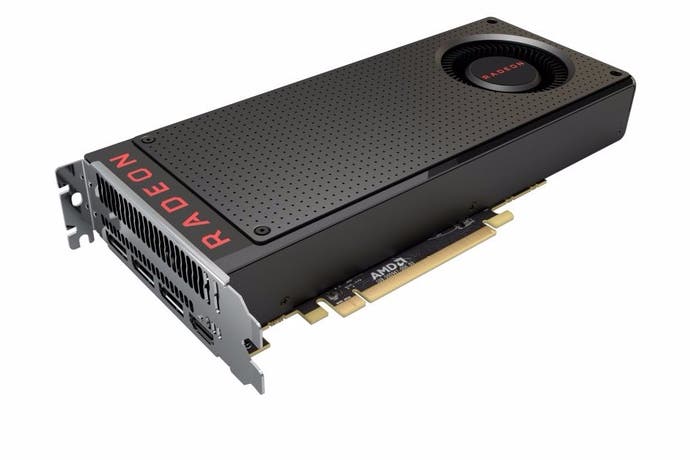AMD's Polaris-powered RX 480 graphics card priced at $199
Aggressive pricing for GTX 970/R9 390-beating performance.
AMD has revealed the Radeon RX 480 graphics card - its debut GPU based on the new Polaris graphics technology. Set to go on sale on June 29th priced at $199, the RX 480 has been validated for premium VR PC gaming and should offer ballpark performance equivalent to GTX 970/980 and AMD's own R9 390/390X.
The technical make-up of the card reveals 36 compute units with a total of 2306 shaders, paired with a 256-bit memory interface. According to AMD we should expect to see cards released with either 4GB or 8GB of GDDR5, and a theoretical maximum of 256GB/s of bandwidth. We should expect to see HDMI 2.0 and HDCP 2.2 support for high-end 4K functionality, and DisplayPort 1.3 and 1.4 is also confirmed, along with HDR. The card has a 150W TDP - a massive reduction from R9 390 and 390X.
Missing so far from AMD's specs are the all-important clock speeds. This can usually be worked out via the TFLOPs figure, but here AMD is being quite vague, saying only that over five TFLOPs of computational power is on tap in RX 480. However, leaks are suggesting a 1266MHz boost clock, up significantly from the 1000-1050MHz found in the existing R9 390 and 390X. This, combined with architectural enhancements, may help to make up the computational deficit with AMD's older equivalent products, which featured 40 and 44 compute units respectively.
It's also worth noting that - clock-speeds and resultant TFLOPs aside - the specs for RX 480 are point-for-point a match for the GPU in Sony's upcoming PlayStation Neo, all but confirming that the Sony mid-gen console refresh uses both Polaris technology and the new 14nm FinFET chip manufacturing process.
| Polaris 10 | Tonga/Antigua | Hawaii/Grenada | |
|---|---|---|---|
| Products | RX 480 | R9 285/380/380X | R9 290/290X/390/390X |
| Compute Units | 36 | 28/32 (380X) | 40/44 (x90/x90X) |
| RAM | 4GB/8GB GDDR5 | 2GB/4GB GDDR5 | 4GB/8GB GDDR5 |
| Memory Interface | 256-bit | 256-bit | 512-bit |
| Process | 14nmFinFET | 28nm Planar | 28nm Planar |
AMD is positioning the RX 480 as the cheapest PC graphics hardware available capable of meeting the Oculus and SteamVR specification, and there's little doubt that a $200 GPU with this level of power is compelling - but that said, in a world where the VR headsets themselves cost so much more we do wonder about the effectiveness of this as a marketing message, especially as take-up has been fairly low thus far.
However, good VR performance also translates into a great experience when the same hardware is deployed on conventional PC titles. We've tested the R9 390 on just about every major PC release this year and found it to be an excellent performer for 1080p60 gameplay on high and ultra settings, and creditable at 1440p too. Put simply: bringing that level of GPU power to market at $199 is very exciting.
So what about the competition? So far, Nvidia has concentrated on high-end next-gen GPU products with its GTX 1080 and GTX 1070 releases (we will have a review of the latter next week), but it's widely understood that the GTX 1060 - Nvidia's competitor to the RX 480 - is ready to go, and based on a recent leak from Inno3D, it too should offer GTX 970/980 levels of performance. The question is whether the green team will match AMD's highly enticing price-point.










